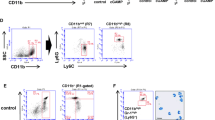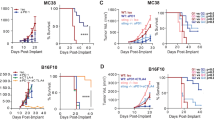Abstract
Stimulator of interferon genes (STING) contributes to anti-tumor immunity by activating antigen-presenting cells and inducing mobilization of tumor-specific T cells. A role for tumor-migrating neutrophils in the anti-tumor effect of STING-activating therapy has not been defined. We used mouse tumor transplantation models for assessing neutrophil migration into the tumor triggered by intratumoral treatment with STING agonist, 2′3′-cyclic guanosine monophosphate-adenosine monophosphate (cGAMP). Intratumoral STING activation with cGAMP enhanced neutrophil migration into the tumor in an NF-κB/CXCL1/2-dependent manner. Blocking the neutrophil migration by anti-CXCR2 monoclonal antibody impaired T cell activation in tumor-draining lymph nodes (dLNs) and efficacy of intratumoral cGAMP treatment. Moreover, the intratumoral cGAMP treatment did not show any anti-tumor effect in type I interferon (IFN) signal-impaired mice in spite of enhanced neutrophil accumulation in the tumor. These results suggest that both neutrophil migration and type I interferon (IFN) induction by intratumoral cGAMP treatment were critical for T-cell activation of dLNs and the anti-tumor effect. In addition, we also performed in vitro analysis showing enhanced cytotoxicity of neutrophils by IFN-β1. Extrinsic STING activation triggers anti-tumor immune responses by recruiting and activating neutrophils in the tumor via two signaling pathways, CXCL1/2 and type I IFNs.





Similar content being viewed by others
Data availability
All data and materials generated during the current study are available from the corresponding authors upon reasonable request.
Abbreviations
- CD:
-
Cluster of differentiation
- CXCL:
-
Chemokine (C-X-C motif) ligand
- CXCR:
-
CXC chemokine receptor
- mAb:
-
Monoclonal antibody
- NF-κB:
-
Nuclear factor-kappa B
References
Lipson EJ, Forde PM, Hammers HJ, Emens LA, Taube JM, Topalian SL (2015) Antagonists of PD-1 and PD-L1 in cancer treatment. Seminars Oncol 42(4):587–600. https://doi.org/10.1053/j.seminoncol.2015.05.013
Fukuhara H, Ino Y, Todo T (2016) Oncolytic virus therapy: a new era of cancer treatment at dawn. Cancer Sci 107(10):1373–1379. https://doi.org/10.1111/cas.13027
Yu S, Li A, Liu Q, Li T, Yuan X, Han X, Wu K (2017) Chimeric antigen receptor T cells: a novel therapy for solid tumors. J Hematol Oncol 10(1):78. https://doi.org/10.1186/s13045-017-0444-9
Yu S, Liu Q, Han X, Qin S, Zhao W, Li A, Wu K (2017) Development and clinical application of anti-HER2 monoclonal and bispecific antibodies for cancer treatment. Exp Hematol Oncol 6:31. https://doi.org/10.1186/s40164-017-0091-4
Yi M, Jiao D, Xu H, Liu Q, Zhao W, Han X, Wu K (2018) Biomarkers for predicting efficacy of PD-1/PD-L1 inhibitors. Mol Cancer 17(1):129. https://doi.org/10.1186/s12943-018-0864-3
Chen DS, Mellman I (2013) Oncology meets immunology: the cancer-immunity cycle. Immunity 39(1):1–10. https://doi.org/10.1016/j.immuni.2013.07.012
Mantovani A, Cassatella MA, Costantini C, Jaillon S (2011) Neutrophils in the activation and regulation of innate and adaptive immunity. Nat Rev Immunol 11(8):519–531. https://doi.org/10.1038/nri3024
Mishalian I, Bayuh R, Levy L, Zolotarov L, Michaeli J, Fridlender ZG (2013) Tumor-associated neutrophils (TAN) develop pro-tumorigenic properties during tumor progression. Cancer Immunol Immunother 62(11):1745–1756. https://doi.org/10.1007/s00262-013-1476-9
Schmidt H, Bastholt L, Geertsen P, Christensen IJ, Larsen S, Gehl J, von der Maase H (2005) Elevated neutrophil and monocyte counts in peripheral blood are associated with poor survival in patients with metastatic melanoma: a prognostic model. Br J Cancer 93(3):273–278. https://doi.org/10.1038/sj.bjc.6602702
Bellocq A, Antoine M, Flahault A, Philippe C, Crestani B, Bernaudin JF, Mayaud C, Milleron B, Baud L, Cadranel J (1998) Neutrophil alveolitis in bronchioloalveolar carcinoma: induction by tumor-derived interleukin-8 and relation to clinical outcome. Am J Pathol 152(1):83–92
Caruso RA, Bellocco R, Pagano M, Bertoli G, Rigoli L, Inferrera C (2002) Prognostic value of intratumoral neutrophils in advanced gastric carcinoma in a high-risk area in northern Italy. Modern pathology : an official journal of the United States and Canadian Academy of Pathology, Inc 15 (8):831–837. https://doi.org/10.1097/01.Mp.0000020391.98998.6b
Ishikawa H, Barber GN (2008) STING is an endoplasmic reticulum adaptor that facilitates innate immune signalling. Nature 455(7213):674–678. https://doi.org/10.1038/nature07317
Ohkuri T, Ghosh A, Kosaka A, Zhu J, Ikeura M, David M, Watkins SC, Sarkar SN, Okada H (2014) STING contributes to antiglioma immunity via triggering type I IFN signals in the tumor microenvironment. Cancer Immunol Res 2(12):1199–1208. https://doi.org/10.1158/2326-6066.Cir-14-0099
Harabuchi S, Kosaka A, Yajima Y, Nagata M, Hayashi R, Kumai T, Ohara K, Nagato T, Oikawa K, Ohara M, Harabuchi Y, Ohkuri T, Kobayashi H (2020) Intratumoral STING activations overcome negative impact of cisplatin on antitumor immunity by inflaming tumor microenvironment in squamous cell carcinoma. Biochem Biophys Res Commun 522(2):408–414. https://doi.org/10.1016/j.bbrc.2019.11.107
Ohkuri T, Kosaka A, Ishibashi K, Kumai T, Hirata Y, Ohara K, Nagato T, Oikawa K, Aoki N, Harabuchi Y, Celis E, Kobayashi H (2017) Intratumoral administration of cGAMP transiently accumulates potent macrophages for anti-tumor immunity at a mouse tumor site. Cancer Immunol Immunother 66(6):705–716. https://doi.org/10.1007/s00262-017-1975-1
Takeo T, Nakagata N (2018) In vitro fertilization in mice. Cold Spring Harbor protocols, (6). https://doi.org/10.1101/pdb.prot094524
Hashimoto M, Takemoto T (2015) Electroporation enables the efficient mRNA delivery into the mouse zygotes and facilitates CRISPR/Cas9-based genome editing. Sci Rep 5:11315. https://doi.org/10.1038/srep11315
Naito Y, Hino K, Bono H, Ui-Tei K (2015) CRISPRdirect: software for designing CRISPR/Cas guide RNA with reduced off-target sites. Bioinformatics (Oxford, England) 31(7):1120–1123. https://doi.org/10.1093/bioinformatics/btu743
Burke SJ, Lu D, Sparer TE, Masi T, Goff MR, Karlstad MD, Collier JJ (2014) NF-kappaB and STAT1 control CXCL1 and CXCL2 gene transcription. Am J Physiol Endocrinol Metab 306(2):E131-149. https://doi.org/10.1152/ajpendo.00347.2013
Weiss JM, Guérin MV, Regnier F, Renault G, Galy-Fauroux I, Vimeux L, Feuillet V, Peranzoni E, Thoreau M, Trautmann A, Bercovici N (2017) The STING agonist DMXAA triggers a cooperation between T lymphocytes and myeloid cells that leads to tumor regression. OncoImmunology 6(10):e1346765. https://doi.org/10.1080/2162402X.2017.1346765
Suschak JJ, Wang S, Fitzgerald KA, Lu S (2016) A cGAS-Independent STING/IRF7 Pathway Mediates the Immunogenicity of DNA Vaccines. J Immunol 196(1):310. https://doi.org/10.4049/jimmunol.1501836
Chen H, Sun H, You F, Sun W, Zhou X, Chen L, Yang J, Wang Y, Tang H, Guan Y, Xia W, Gu J, Ishikawa H, Gutman D, Barber G, Qin Z, Jiang Z (2011) Activation of STAT6 by STING is critical for antiviral innate immunity. Cell 147(2):436–446. https://doi.org/10.1016/j.cell.2011.09.022
Balka KR, Louis C, Saunders TL, Smith AM, Calleja DJ, D’Silva DB, Moghaddas F, Tailler M, Lawlor KE, Zhan Y, Burns CJ, Wicks IP, Miner JJ, Kile BT, Masters SL, De Nardo D (2020) TBK1 and IKKepsilon act redundantly to mediate STING-induced NF-kappaB responses in myeloid cells. Cell Rep 31(1):107492. https://doi.org/10.1016/j.celrep.2020.03.056
Fridlender ZG, Sun J, Kim S, Kapoor V, Cheng G, Ling L, Worthen GS, Albelda SM (2009) Polarization of tumor-associated neutrophil phenotype by TGF-beta: “N1” versus “N2” TAN. Cancer Cell 16(3):183–194. https://doi.org/10.1016/j.ccr.2009.06.017
Jablonska J, Leschner S, Westphal K, Lienenklaus S, Weiss S (2010) Neutrophils responsive to endogenous IFN-beta regulate tumor angiogenesis and growth in a mouse tumor model. J Clin Invest 120(4):1151–1164. https://doi.org/10.1172/jci37223
Fridlender ZG, Albelda SM (2012) Tumor-associated neutrophils: friend or foe? Carcinogenesis 33(5):949–955. https://doi.org/10.1093/carcin/bgs123
Jablonska J, Wu CF, Andzinski L, Leschner S, Weiss S (2014) CXCR2-mediated tumor-associated neutrophil recruitment is regulated by IFN-β. Int J Cancer 134(6):1346–1358. https://doi.org/10.1002/ijc.28551
Takeshima T, Pop LM, Laine A, Iyengar P, Vitetta ES, Hannan R (2016) Key role for neutrophils in radiation-induced antitumor immune responses: Potentiation with G-CSF. Proc Natl Acad Sci U S A 113(40):11300–11305. https://doi.org/10.1073/pnas.1613187113
Fuchs Y, Steller H (2015) Live to die another way: modes of programmed cell death and the signals emanating from dying cells. Nat Rev Mol Cell Biol 16(6):329–344. https://doi.org/10.1038/nrm3999
Matzinger P (2002) The danger model: a renewed sense of self. Science (New York, NY) 296(5566):301–305. https://doi.org/10.1126/science.1071059
Bellamy CO, Malcomson RD, Harrison DJ, Wyllie AH (1995) Cell death in health and disease: the biology and regulation of apoptosis. Semin Cancer Biol 6(1):3–16. https://doi.org/10.1006/scbi.1995.0002
Krysko DV, Agostinis P, Krysko O, Garg AD, Bachert C, Lambrecht BN, Vandenabeele P (2011) Emerging role of damage-associated molecular patterns derived from mitochondria in inflammation. Trends Immunol 32(4):157–164. https://doi.org/10.1016/j.it.2011.01.005
Spencer DM, Mobarrez F, Wallén H, Pisetsky DS (2014) The expression of HMGB1 on microparticles from Jurkat and HL-60 cells undergoing apoptosis in vitro. Scand J Immunol 80(2):101–110. https://doi.org/10.1111/sji.12191
Acknowledgments
The authors thank Dr. Tadatsugu Taniguchi for providing IRF3-KO and IRF7-KO and Mr. Hayakawa Toshiyuki and Ms. Hino Chihiro (at the Animal Laboratory for Medical Research, Center for Advanced Research and Education, Asahikawa Medical University) and Ms. Matsumoto Rie (at the Department of Pathology, Asahikawa Medical University) for devotedly maintaining the mice. This work was supported by the Akiyama Life Science Foundation to T. Ohkuri.
Funding
This study was supported by the grants from the Akiyama Life Science Foundation (T. Ohkuri).
Author information
Authors and Affiliations
Contributions
MN, AK, TO, and HK designed and preformed experiments; MN and TO analyzed results and made the figures; JU and HF generated IFNAR1KO mice; MN, AK, TO, YY, SY, MO, KO, SH, RH, TK, TN, KO, NA, YH, CE, and H.K. discussed the results; MN, TO, and HK wrote the paper. All authors read and approved the final manuscript.
Corresponding authors
Ethics declarations
Conflict of interest
The authors declare no competing interests.
Ethics approval
Animal use protocol was approved by the Asahikawa Medical University Institutional Animal Care and Use Committee (approval no. 19111). This study was performed in accordance with the Declaration of Helsinki.
Availability of data and material
All data and materials generated during the current study are available from the corresponding authors upon reasonable request.
Additional information
Publisher's Note
Springer Nature remains neutral with regard to jurisdictional claims in published maps and institutional affiliations.
Supplementary Information
Below is the link to the electronic supplementary material.
Rights and permissions
About this article
Cite this article
Nagata, M., Kosaka, A., Yajima, Y. et al. A critical role of STING-triggered tumor-migrating neutrophils for anti-tumor effect of intratumoral cGAMP treatment. Cancer Immunol Immunother 70, 2301–2312 (2021). https://doi.org/10.1007/s00262-021-02864-0
Received:
Accepted:
Published:
Issue Date:
DOI: https://doi.org/10.1007/s00262-021-02864-0




